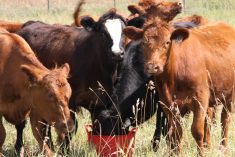Livestock producers are being warned after recent frosts put some feed at risk of having higher than normal levels
Beef and forage specialists are warning livestock producers to be on the alert about potentially high levels of nitrate in their feed.
High levels of nitrate, which can cause death in animals, might be prevalent because of recent cold spells on the Prairies.
Karin Lindquist, a beef and forage specialist with Alberta Agriculture, said the level of nitrate in feed will depend on frost activity.
She said plants that are frosted in the -1 C to -3 C range don’t die but will take in extra nitrate to repair themselves, therefore increasing levels. Levels should return to normal 10 to 12 days after the frost.
Read Also

Animal protection delivery to change in Saskatchewan
The Saskatchewan government is looking for a new agency to handle animal welfare after Animal Protection Services of Saskatchewan decided not to renew its contract next year.
However, issues can arise when killing frosts enter the picture. Killing frosts are in the -4 C or colder range.
Lindquist said if plants are killed by frost during the repair phase, which is when nitrate levels are high, those high levels will be locked in and remain in the feed.
“If a killing frost happens four to seven days after that first initial injury frost, then those plants are killed and the producer will be stuck with the nitrates that are there,” she said.
However, frost isn’t the only cause of high nitrates.
Lindquist said the amount of nitrogen fertilizer that was applied to the soil also plays a role. If no fertilizer was put down, nitrate levels are expected to be much lower than if lots of product was applied.
“If there is extra fertilizer, there would be higher levels of nitrates when the plant is injured by the frost,” she said.
Lindquist said cereals are the most common crops to experience nitrate issues, though it also can affect brassicas such as canola. Alfalfa and nearly all the legumes aren’t affected, she added.
That means producers feeding annual crops this winter are going to have to pay closer attention, though not all is lost.
Saskatchewan Agriculture, which also released a warning about potentially high nitrate levels, said in an advisory that livestock can consume nitrate levels of one percent or higher as long as they are conditioned to it and are in good shape.
To condition the animals, the ministry said producers can feed small amounts of high nitrate feed at intervals during the day. During the conditioning period, which takes about one to two weeks, feeds should not contain more than 0.5 percent nitrate.
High-nitrate and regular feed must be physically mixed together to get livestock adjusted. The ministry said putting out one bale of high-nitrate feed along with one or more bales of low-nitrate feed isn’t acceptable. If mixing isn’t possible, producers should put out low-nitrate feed at the beginning of each feeding and then follow up with a higher-nitrate feed.
Lindquist said producers can determine nitrate levels by sending samples to feed labs for testing. A test can take three or four days, or slightly longer.
When sending plants for testing, she recommended that they be cut four to six inches from the soil rather than pulled by the root. They should also be cut from different locations, such as on a hill and in a valley.
There can be deadly consequences if producers aren’t diligently tracking levels.
“When animals are suddenly consuming high nitrate levels, they can get acute toxicity,” Lindquist said.
“They can lose animals within a few hours. It acts pretty darn quickly.”
Symptoms of lethal nitrate poisoning include laboured breathing, frothing in the mouth, rapid pulse, weakness, diarrhea, frequent urination, muscle tremors, unco-ordination and convulsions, collapse and death.
Livestock that have received non-lethal doses but are still experiencing symptoms can have a loss of appetite, reduced milk production, slow growth and abortions.
Saskatchewan Agriculture warned that damp hay, straw or fodder suspected of being high in nitrate shouldn’t be fed to animals. Damp feed seems to be more toxic.















